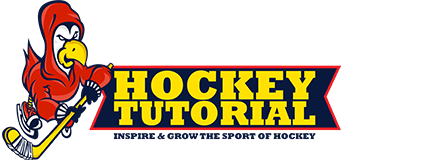A famous NHL player once commented, “I’ll never pass to a teammate who has his stick in the air – I don’t know where he wants the pass.” Players need to have a target for their passes, and a stick waving around in the air doesn’t make a very good target. Holding the stick with one hand helps you to keep the stick close to or on the ice. Of course, you must learn where on the ice to keep the hockey stick and when to put the other hand on the stick. Having the stick on the ice at all times also increases the chance that a loose might end up on your stick rather than on someone else’s.
Regardless of whether you skate with the stick in one hand or two, when you skate straight forward or straight backward the arm swing is also forward and backward. Referees, who do not use a hockey stick, should learn to use the same forward/backward arm swing.
A forward/backward arm swing enhances forward momentum. A side to side arm swing enhances sideways momentum. So, when moving sideways (in hockey we call this lateral mobility), you should move your arms sideways (along the desired direction of travel).
On the ice
 1. Arm swing – In forward skating, most people generally swing their arms side to side but it’s better to swing your arms forward and back. Many hockey players know this but often don’t do it. Forward arm swinging is very important, it will increase your speed and you’ll soon see results. Try starting this technique by initially exaggerating the arms. Remember to keep your elbows in.
1. Arm swing – In forward skating, most people generally swing their arms side to side but it’s better to swing your arms forward and back. Many hockey players know this but often don’t do it. Forward arm swinging is very important, it will increase your speed and you’ll soon see results. Try starting this technique by initially exaggerating the arms. Remember to keep your elbows in.
Avoid swinging your arms in a east west motion, instead swing your arms north working with your forward stride to drive you forward more efficiently. One of the most important points is NOT to have your arms straightened out swinging back and fourth, have them locked at a 45degree angle preventing you from wasting energy and time.
 2. Knee bend – We all know bending the knee is essential, but oftentimes we don’t know how low we should go. The trick is to try to be in a position where the lower part of the upper leg is parallel or almost parallel to the ice. When you’re almost in a sitting down position your knees should be bent around 88 degrees. Keep your shoulders back and take longer strides.
2. Knee bend – We all know bending the knee is essential, but oftentimes we don’t know how low we should go. The trick is to try to be in a position where the lower part of the upper leg is parallel or almost parallel to the ice. When you’re almost in a sitting down position your knees should be bent around 88 degrees. Keep your shoulders back and take longer strides.
 3. Wide stride – It is important to push wide (push to the side) when you skate. Many people tend to push behind in their stride, but this means you are pushing more of your toe against the ice, which isn’t as efficient as pushing the whole blade. A good way to remember to have a wide stride is to make sure the full blade is on the ice when you are driving your leg out (the toe should be the last part of the blade off the ice when recovering the leg). This takes less energy and in return gives you more energy to go faster.
3. Wide stride – It is important to push wide (push to the side) when you skate. Many people tend to push behind in their stride, but this means you are pushing more of your toe against the ice, which isn’t as efficient as pushing the whole blade. A good way to remember to have a wide stride is to make sure the full blade is on the ice when you are driving your leg out (the toe should be the last part of the blade off the ice when recovering the leg). This takes less energy and in return gives you more energy to go faster.
Practicing off the ice – You can also improve your skating when you’re not at the rink or the pond. Skating fast takes leg quickness, strength, balance and flexibility and furthermore, it takes a good attitude. An arrogant or bad attitude can be a hockey player’s greatest hurdle. If a player is good at skating, but not open to getting better, he or she won’t get better.
Tips for achieving a forward/backward arm swing:
- Most players understand that it’s important to fully extend the legs during each stride, remembering to recover the leg the same direction it went out. Keep your legs low when recovering.
- Arms lock and swing back and fourth in conjunction with the bodies movement
- Because the arms and legs naturally work in unison, it’s also important to use your arm swing enhances forward momentum.
- Move the arms forward and backward in such a way that the elbows stay close to your ribs as they move. If the elbows stay wide as they swing your arms will be forced to move sideways rather than forward and back.



